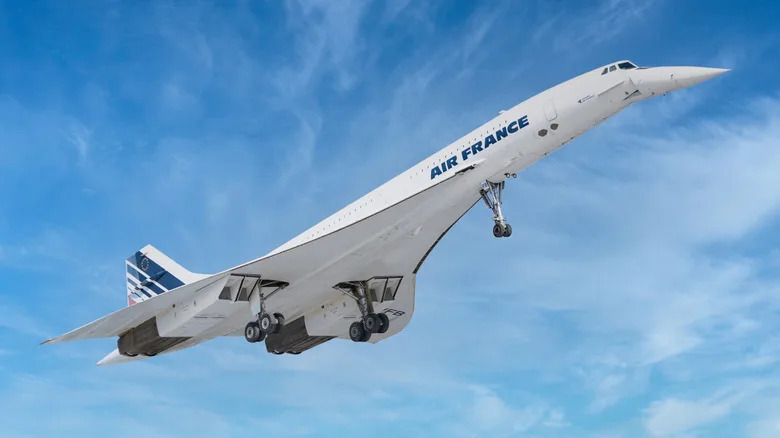In the late ’90s, Pepsi found itself in dire straits. The age-old Coke versus Pepsi rivalry was in full swing, and unfortunately for Pepsi, Coca-Cola was holding down a significantly larger portion of the soda market. But the folks at Pepsi were not going to take this sitting down. No, they set out on an absolutely massive $500 million rebranding campaign dubbed “Project Blue.”
If you aren’t a scholar of the history of Pepsi branding, you can probably still guess the main thrust of this campaign: Pepsi was going blue. Not in the sense of the soda itself, though Pepsi did launch a blue-colored soda a few years later. In this case, the focus was solely on branding. The red, white, and blue circle with a wavy line remained, but the white background was replaced with the now-familiar royal blue across the brand, including the cans. But the cans were not the only piece of aluminum taking on this new hue. A major facet of the Project Blue campaign was a Pepsi-branded Concorde jet.
Air France won the bid to operate the Pepsi Concorde, and the paint job was undertaken in secret at a facility in Paris and then transferred to London for the big reveal. The event took place at Gatwick Airport and featured extensive fanfare. This was, after all, the first release of the blue Pepsi can, and the soda giant wasn’t going to let that happen without a show. The event is estimated to have cost around $5 million to produce and featured light shows, supermodels on motorbikes, and, yes, a blue Concorde. Unfortunately, it turns out that royal blue is not a great color for a supersonic aircraft.
Read more: 13 Retired ’90s Candies We’re Nostalgic For
The downside to painting a Concorde in Pepsi blue
Air France concorde jet in flight – Herget Josef/Shutterstock
The Concorde was a special jet in the commercial aviation world. It was the first successful supersonic commercial aircraft, capable of traveling at Mach 2.04 — more than twice the speed of sound — or around 1,565 miles per hour. At that speed, a flight from New York City to London takes less than three hours. British Airways clocked one flight along that path at 2 hours, 52 minutes, and 59 seconds. But to accomplish such speeds, these aircraft were operating at the absolute limit, and it turns out that the color of paint on the aircraft was a significant factor in maintaining this cutting-edge performance.
Traditionally, Concorde jets were painted white, and for good reason: The white exterior allowed them to more effectively dissipate heat. Traveling at supersonic speeds, these jets receive a significant amount of frictional heat from the air through which they are traveling. This frictional heat could bring the temperature of the aircraft’s nose up to 212 degrees Fahrenheit, and the fuselage to 194 degrees Fahrenheit. A specialized white paint helped to radiate this heat away for most of the Concorde fleet, but not in the Pepsi jet — and the result was a significant decline in performance.
Because of the change in the fuselage color, the Pepsi-branded Concorde was advised not to travel at top speed for more than 20 minutes. Despite this restriction, however, the aircraft was able to operate at Mach 1.7 indefinitely. That is still 1,304 miles per hour, or more than twice as fast as most modern commercial planes. Air France chose a shorter route for the Pepsi-branded Concorde — a flight that would never reach top speed to begin with — so the reduced speed was not an issue.
Pepsi’s other successful and unsuccessful forays into aviation
a Vueling airplane with Pepsi Max branding on it – Santirf/Getty Images
This was not Pepsi’s only foray into aviation. Shortly after the Concorde was unveiled, the brand released the first advertisement shot in space. Cosmonauts aboard the Mir space station unveiled a 4-foot replica of the new Pepsi can while on a space walk. The exact cost of this groundbreaking stunt is unclear, with sources reporting anywhere from $5 million to a staggering — and probably exaggerated — $300 million.
The brand also ran into significant controversy with one of its aviation-focused promotions. Around the same time period, Pepsi introduced Pepsi Points, a rewards system wherein customers could collect labels and exchange them for Pepsi-branded merchandise. Most of the rewards were fairly standard, such as hats and t-shirts, which could be had in exchange for 60 and 75 Pepsi Points, respectively. But at the top of the list, the company jokingly listed a Harrier fighter jet for 7 million Pepsi Points. Much to the chagrin of the soda giant, someone actually collected those points. A loophole allowed that Pepsi Points could be purchased for $0.10 each, which meant that 7 million would only cost $700,000. The word “only” is doing a lot of work there, but when it comes to a $23 million fighter jet, that’s a pretty dang good deal. Unfortunately, despite one individual by the name of John Leonard successfully collecting the required points, Pepsi was able to fight its way out of the obligation in court.
Since then, Pepsi has stuck to more reasonable aviation-related branding, such as putting its logos on the sides of run-of-the-mill commercial aircraft. But with Pepsi seeking to reignite the cola wars in 2025, who’s to say what aerial madness might be in the pipeline?
Want more food knowledge? Sign up to our free newsletter where we’re helping thousands of foodies, like you, become culinary masters, one email at a time. You can also add us as a preferred search source on Google.
Read the original article on Tasting Table.

